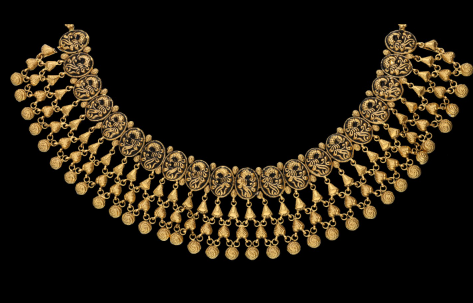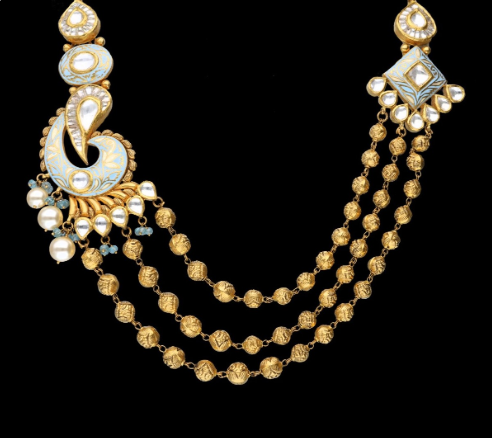Antique Jewelry holds a timeless allure that transcends trends, making it one of the most cherished forms of adornment across generations. From royal heirlooms to vintage market finds, antique jewelry is prized not just for its beauty, but for the rich history and craftsmanship it embodies. At KundanMala Jewels, we understand the legacy and cultural significance behind every piece of antique jewelry, making us a trusted name in preserving and offering this heritage.
So, what truly makes antique jewelry so valuable? The answer lies in a blend of rarity, craftsmanship, historical relevance, and emotional connection.
Age and Rarity Add Intrinsic Value
One of the core elements that define antique jewelry is its age. Typically, jewellery older than 100 years falls under the ‘antique’ category. These pieces often belong to historical eras such as the Victorian, Edwardian, or Mughal periods. Because of their limited availability and unique styles, antique jewelry pieces are considered rare collectibles. Rarity naturally increases value, making each item a unique investment.
As time passes, fewer pieces of genuine antique jewelry remain in circulation, enhancing their appeal to collectors and enthusiasts. The historical significance of such pieces further amplifies their worth—each one is a tangible link to the past. Their survival over a century or more often means they were created using high-quality materials and enduring craftsmanship, allowing them to stand the test of time.
Moreover, trends in modern jewellery are often cyclical, drawing inspiration from antique styles. As a result, authentic antique jewelry becomes not just a collector’s item but also a fashion statement. This dual appeal ensures that antique jewelry retains both historical and contemporary relevance. Collectors, historians, and fashion-conscious buyers alike view these pieces as valuable assets that combine aesthetic pleasure with significant heritage.

Unmatched Craftsmanship
The intricate handwork seen in antique jewelry is a testament to the artisan skills of earlier times. Craftsmen from past centuries relied solely on manual tools and techniques, carefully crafting every detail by hand. This resulted in designs that were not only aesthetically unique but also structurally robust. The absence of machinery meant every curve, cut, and setting was thoughtfully executed, often taking weeks or months to complete a single piece.
In an era when jewellery was considered an art form rather than mere ornamentation, artisans took immense pride in their craft. Techniques such as hand engraving, filigree, enamelling, and granulation were applied with painstaking precision. These methods required not just skill but also patience and passion—qualities that are evident in the enduring beauty of each antique jewelry design.
Furthermore, antique jewelry often showcases regional craftsmanship styles that have either evolved or become obsolete over time. Whether it’s the elaborate Rajasthani jadau, the intricate South Indian temple motifs, or the delicate meenakari from Persia-influenced designs, each piece tells the story of the region and culture it originated from.
Unlike today’s mass-produced items, no two pieces of genuine antique jewelry are exactly alike. This uniqueness enhances their value, both artistically and monetarily. For collectors and connoisseurs, owning a piece of antique jewelry is akin to holding a miniature work of historical art—something that reflects timeless mastery and human ingenuity.
Historical Significance
Every piece of antique jewelry carries with it a story, and that story is often steeped in a rich tapestry of cultural and historical contexts. For instance, a piece of antique jewelry from the Mughal era might not only reflect Islamic artistic influence but also the political dynamics, fashion, and societal norms of that time. Similarly, jewellery from the Victorian or Edwardian eras might embody the elegance, symbolism, and materials favored by European royalty.
Many pieces were custom-designed for aristocrats or nobility, and some have even been worn by historical figures, which adds an almost mythic layer of value. The provenance of these items often enhances their appeal—whether they were worn at royal weddings, used in ancient rituals, or gifted during significant political alliances. These narratives create a strong emotional and intellectual pull, especially for collectors and historians.
The historical weight of antique jewelry transforms it from a simple decorative item to a significant artifact. This aspect makes it not only a valuable addition to personal collections but also worthy of museum displays, auctions, and academic studies. People who invest in antique jewelry aren’t just purchasing a product—they’re acquiring a living piece of history.

Unique Materials and Techniques
What sets antique jewelry apart from modern counterparts is the exclusive use of superior and often rare materials. Many of these pieces feature natural, unenhanced gemstones such as Burmese rubies, Colombian emeralds, and Golconda diamonds—stones that are now either exhausted or heavily restricted in trade. The gold used in antique jewelry was typically of a higher purity, often handcrafted and alloyed using traditional techniques that have since faded from mainstream production.
The crafting techniques used also add immense value. Ancient artisans employed meticulous methods such as kundan setting, polki diamond work, and intricate meenakari enameling—skills passed down through generations and often kept within specific artisan communities. These methods were labor-intensive and time-consuming, involving hand tools and fire techniques that demanded absolute precision and dedication.
Moreover, some of these techniques are now considered endangered, with very few craftsmen alive today who can replicate the quality and style seen in historical pieces. This makes every piece of antique jewelry not just beautiful but rare in technique and design. Owning such jewellery means preserving a segment of art history that may soon vanish.
In essence, the materials and craftsmanship embedded in antique jewelry ensure its uniqueness and enduring value. Each piece is an irreplaceable blend of artistry and nature, making it a truly prized possession.
Emotional and Sentimental Worth
One of the most profound aspects that elevate the value of antique jewelry is its sentimental and emotional significance. These pieces are often treasured as heirlooms, passed down through generations and carrying with them deeply personal stories, values, and traditions. A ring worn by a great-grandmother on her wedding day or a necklace gifted on a golden jubilee holds immense emotional meaning that no modern piece can replicate.
Even when newly acquired, antique jewelry can evoke a powerful sense of nostalgia. The vintage designs, aged patinas, and timeless aesthetics all contribute to the charm that connects wearers to a bygone era. This emotional connection is a key reason why many people choose to invest in antique jewelry—not just for its market value, but for the joy, memories, and legacy it brings into their lives.
A Smart Long-Term Investment
As demand continues to grow, antique jewelry is increasingly seen as a valuable asset. Unlike trendy or mass-produced pieces, antique jewelry tends to appreciate in value over time, especially when well-maintained. Its scarcity, artistic merit, and historical significance make it an attractive option for collectors and investors looking to diversify their portfolios with tangible assets.
Economic fluctuations have led more individuals to explore alternative forms of investment, and antique jewelry offers both stability and potential for growth. Auctions and estate sales frequently see such items fetching impressive sums, particularly when accompanied by proper documentation and provenance.
This dual benefit—artistic pleasure and financial return—is one reason why seasoned connoisseurs and new buyers alike are drawn to antique jewelry. Choosing reputable sources, such as the best jewellers in Dehradun, ensures authenticity and enhances long-term value.
Sustainability and Eco-Friendliness
In today’s world, where environmental consciousness is increasingly important, antique jewelry stands out as a sustainable choice. Unlike modern jewellery that often involves extensive mining and manufacturing, antique jewelry requires no new extraction of resources. Repurposing, restoring, and wearing antique pieces contribute to reducing carbon footprints and promoting circular fashion.
This eco-conscious aspect of antique jewelry especially appeals to younger buyers who value sustainable practices. Each piece represents a form of ethical luxury—where beauty meets responsibility. By choosing antique jewelry, wearers support not only artistry but also the planet.
Customization Possibilities
One of the modern advantages of owning antique jewelry is the potential for customization. Skilled jewellers can resize rings, replace worn-out clasps, or even reset stones—making the piece more wearable while retaining its original essence. This blend of old-world charm with contemporary adaptability allows wearers to enjoy antique jewelry in a way that feels personal and relevant.
Customization doesn’t dilute the value; in fact, thoughtful modifications can increase usability and aesthetic appeal, making the jewellery more meaningful to the current owner while preserving its historic core. It offers the best of both worlds: tradition and individuality.
Cultural Representation
Antique jewelry often reflects the cultural richness and regional traditions of its era. From the ornate temple jewellery of South India to the regal jadau pieces from Mughal-influenced North India, each piece serves as a cultural artifact. These styles encapsulate the essence of specific communities, rituals, and historical moments, offering a deep sense of identity and pride.
Wearing or collecting antique jewelry becomes an act of cultural preservation. For many, it’s not just about style or status—it’s about honoring heritage. This cultural depth adds another layer to its overall value, making antique jewelry significant on personal, artistic, and societal levels.

Authenticity and Certification
One of the most critical factors that determine the value and desirability of antique jewelry is its authenticity. With the growing interest in vintage and historical pieces, the market has also seen a rise in reproductions and imitations. This makes documentation—such as provenance certificates, gem grading reports, and historical ownership records—essential for serious buyers and collectors.
Provenance certificates trace the history of a piece, confirming its origin, age, and prior ownership. Such documentation not only enhances the credibility of antique jewelry but also adds emotional and historical depth to the piece. It provides buyers with a transparent record, reducing the risk of counterfeit purchases and giving peace of mind that the investment is genuine.
As awareness increases, more customers are actively seeking certified pieces to ensure they’re purchasing true antique jewelry rather than vintage-inspired replicas. Certification by recognized gemological institutes or heritage experts strengthens the value of the jewellery in the eyes of both collectors and resellers. It’s a mark of trust and a way to distinguish premium antique pieces in an increasingly competitive market.
Reputable jewellers—such as KundanMala Jewels—prioritize transparency and integrity by offering fully authenticated and certified antique pieces. Their commitment to quality standards, expert verification, and customer education ensures that each purchase is both meaningful and secure. For anyone looking to invest in antique jewelry, certification isn’t just a formality—it’s a foundation of value and trust.
Conclusion
Antique jewelry is not merely about aesthetics—it’s a confluence of history, art, culture, and emotion. From the exceptional craftsmanship to the rich heritage and emotional connections, each piece holds a story worth cherishing. As one of the best jewellers in Dehradun, KundanMala Jewels takes immense pride in offering genuine antique jewelry that resonates with timeless value and grace. Whether for personal adornment or as a treasured family heirloom, Antique Jewelry remains a wise and beautiful investment for generations to come.
The age, craftsmanship, and stories behind each piece make antique jewelry a timeless treasure. At KundanMala Jewels, our carefully curated antique collection reflects our commitment to quality and authenticity, setting us apart as one of the best jewellers in Dehradun. Whether you’re a collector, a bride-to-be, or someone drawn to history, antique jewelry offers an unparalleled charm and legacy worth investing in.
For those searching for trusted and exquisite pieces, KundanMala Jewels remains among the best jewellers in Dehradun, bringing heritage to life—one timeless piece at a time.






